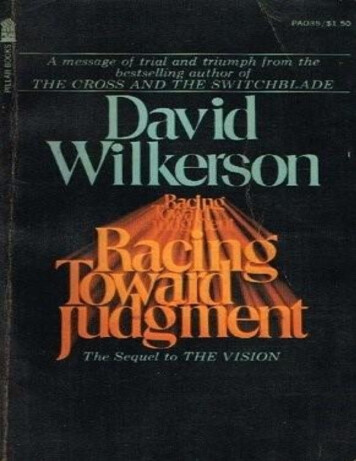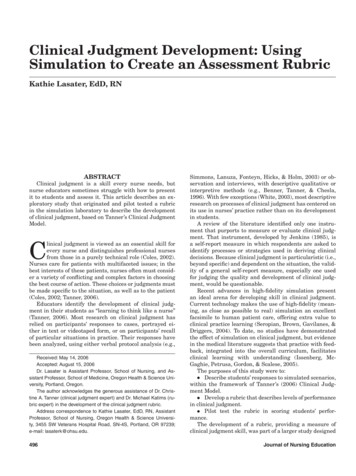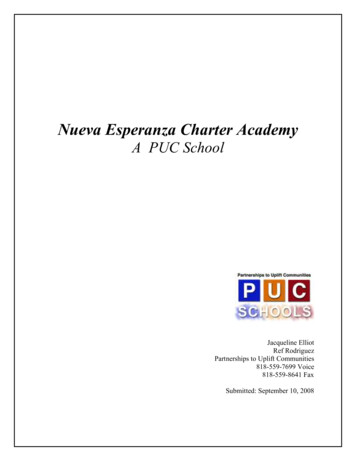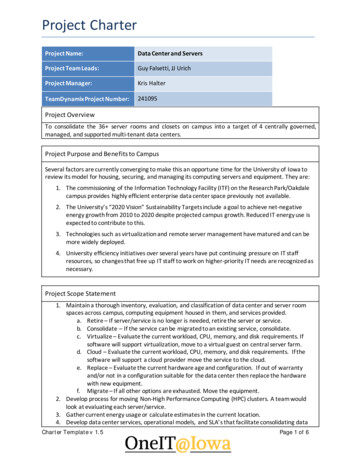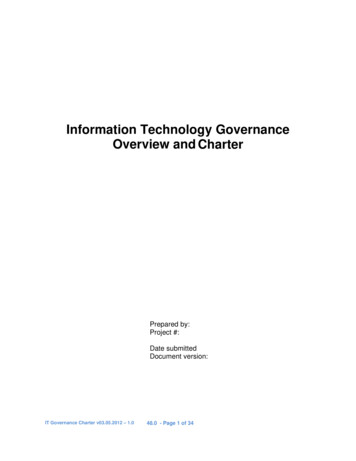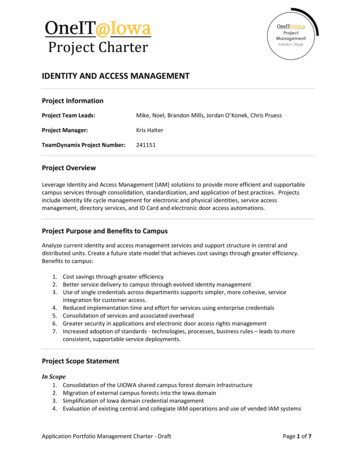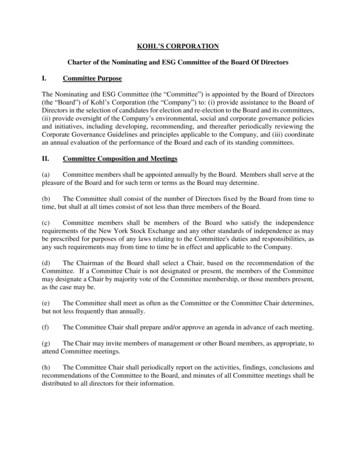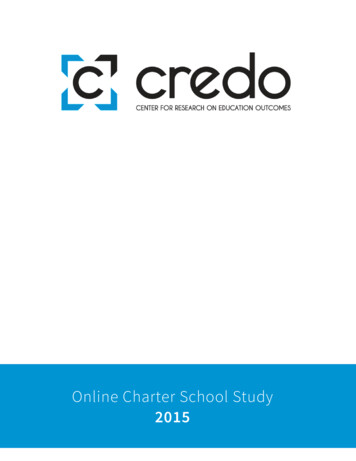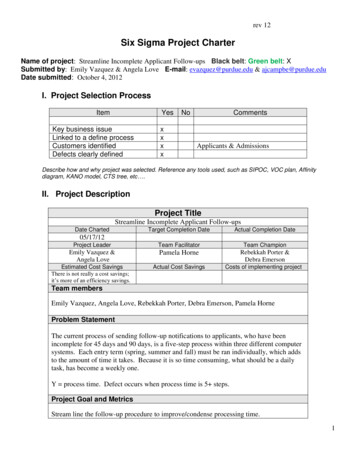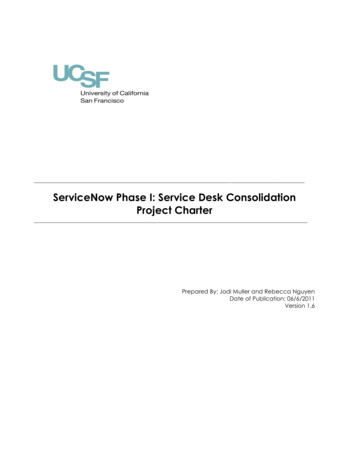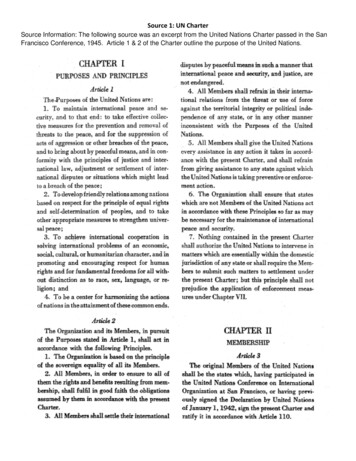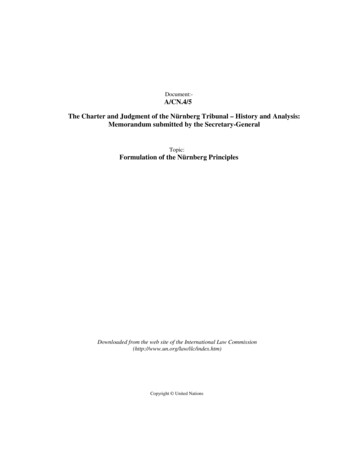
Transcription
Document:-A/CN.4/5The Charter and Judgment of the Nürnberg Tribunal – History and Analysis:Memorandum submitted by the Secretary-GeneralTopic:Formulation of the Nürnberg PrinciplesDownloaded from the web site of the International Law yright United Nations
THE CHARTER AND JUDGMENTOF TIlE NURNBERG TRIBUNALHISTORY AND ANALYSIS(Memorandum submitted by the Secretary-General)United Nations - General AssemblyInternational Law CommissionLake Success, New York1949.
TABLE OF CONTENTSPageINTRODUCTION.PART 1.1. The2. The3. The4. TheSURVEY OF THE NURNBERG CHARTER AND TRIALMoscow Declaration, 1943. . . . . . . . . . . . . .London Agreement, 1945. . . . . . . . . . . . . . . . . . . . . . . . . . . .Charter of the International Military Tribunal. . . .indictment5. The trial.6. The judgment and serxtence. . . . . . . . . . . . . . . . . . . . . . . . . . . . . .PART H. CONSIDERATION IN THE UNITED NATIONS OF PLANS FORFORMULATION OF THE PRINCIPLES OF THE NiiRNBERG CHARTERJUDGMENTI. The second part of the first session of the General Assembly(23 October to 16 December 1946) . . . . . . . . . . . . . . . . . . . . . .2. The Committee on the Progressive Development of International Law and its Codification (12 May to 17 June 1947)A. Summary of proceedings. . . .B. Resume of discussions on the main points at issue. . . . . . .(1) The question of the competence of the Committee:deyis ng plam for the formulation of the Niirnbergprmoples. . . . . . . . . . . . . . . . . . . . . . . . . . . . . . . . . . . . . . .(2) A. aft conven ion incorporating the NiirnbergpnncIples . . . . . . . . . . . . . . . . . . . . . . . . . . . . . . . . . . . . . . .(3) General codification )f offences against the peace andsecurity of mankind, and/or an international criminalcode(4) :rh . 9u stion of an internation'al court of criminalJunsdlctlOn(5) The proposal of the Polish representative relating towar propaganda3. The second session of the General Assembly (16 September to29 November 1947),V334567THEAND111519192121232930PART HI. ApPLICATION OF THE CHARTER BY THE NiiRNBERGTRIBUNAL37I. Legal nature of the Charter2. Criminal responsibility of individuals under international law.Acts of State. Superior orders. . . . . . . . . . . . . . . . . . . . . . . . . . . .A. Objections of the defence . . . . . . . . . . . . . . . . . . . . . . . . . . . .B. Contentions of the prosecution. . . . . . . . . . . . . . . . . . . . . . . .C. Findings of the Court. . . . . . . . . . . . . . . . . . . . . . . . . . . . . . .3. International crimes in generaliii3939404142
Page4. Crimes against peaceA. Categories of crimes against peace . . 46B. Awessive war. 47C. War in violation of international treaties, agreements orassurances. 49D. The common plan or conspiracy. 50(1) Contentions of the prosecution:. 50(2) Objections vf the defence. 51(3) Findings of the Court . . . . . . . . . . . . 51(a) Common, concrete planning. 5355(b) Objectiye of conspiracy.E. Planning, preparation, initiation or waging of a criminalwar5556(1) Planning and preparation. . .(2) Initiation58(3) Waging585. War crimesA. Definition. 61B. War crimes as violations of the laws or customs of war. 626. Crimes agaimt humanityA. Definition. 65B. General declaration of tbe Court as to crimes againsthumanity . . . . . . . . . . . . . . . . . . . . . . . . . . . . . . . . . . . . . . . . 66C. Categories of crimes against humanity. . . . . . . . . . . . . . . . . . 67D. Requirement that crimes against humanity be connectedwith crimes against peace or war crimes. . . . . . ., 68E. Superiority of article 6 (c) over internal law. . . . . . . . . . . 69F. Persons capable of committing crimes against humanity. 70G. Crimes against humanity and existing international law . , 707. Responsibility of leaders, organizers, instigators and accomplices, 728. Criminal organization A. Provisions of the Charter. 74B. Contentions of the prosecution . . . 75C. Objections of the defence. 76D. Findings of the Court. 769. Jurisdiction,. 79Addendum:The trial of major Japanese war criminals. 81Appendices:I. Moscow Declaration on German atrocities of 30 October1943. 87n. Agreement for the establishment of an international military tribunal . . . . . . . . . . . . . . . . . . . . . . . . . . . . . . . . . . . . . . . . 89iv
PageIntroduction4647tents orThe General Assembly, at its second session, on 21 November1917, adopted a resolution (177 (II» in which it entrusted the formulation of the principles of international law recognized in the Charterof the Nfirnberg Tribunal and in the judgment of the Tribunal tothe Interna.tional Law CoIIJJcission. The resolution reads as follows:49505051515355Formulation of the principles recognized in the Charter of the NilrnbergTribunal and in the judgment of the TribunalThe General Assembly:riminal55565858war .againstmnectednanity .l1aw .l accom-Decides to entrust the formulation of thr. principles of international lawrecognized in the Charter of the Niirnberg Tribunal and in the judgmentof the Tribunal to the International Law Commission, the members ofwhich wil!, in accordance with resolution 174 (Il), be elected at the nextsession of the General Assembly, and lDirects the Commission to6162(a) Formulate the principles of international law recognized in theCharter of the Niirnberg Tribunal :md in the judgment of the Tribunal,and65(b) Prepare a draft code of offences against the peace and security ofmankind, indicating clearly th.e place to be accorded to the principles mentioned in sub-paragraph (a) above.6667By another resolutiun adopted on the same day (175 (II», theGeneral Assembly instructed the Secretary-C eral to do the necessarypreparatory work for the beginning of the activity of the IntemationalLaw Commission. The following is the text of this resolution:68697070Preparation by the Secreta.riat of the work of theInternational Law CommissionThe General Assembly,72Considering that, in accordance with Article 98 of the Charter, theSecretary-General performs all such functions as are entrusted to him by theorgans of the United Nations;74757676. 79. . .Considering that, in the interval between the first and the second sessionf of the General Assembly, the Secretariat of the Un:ted Nations contributed to the study of problems concerning the progressive developmentof intemationallaw and its codification;81Instructs the Secretary-General to do the necessary Dreparatory workfor .the beginning of the activity of the International Law ·Commission, particularly with regard to the questions referred to it by the second session ofthe General Assembly, such as the draft declaration on the rights and dutiesof States.October. . 87Inal mili. 89The present memorandum is prepared in pursuance of theabove-quoted resolution .
PART ISurvey of the Niirnberg Charter and Tr.ial
1. THE MOSCOW DECLARATION, 1943The determination of the Allies to punish the major war criminals of the European Axis first found expression in the Moscow Conference, 1943. By a "Declaration on German Atrocities",l dated 30October 1943, the Governments of the United Kingdom, the UnitedStates and the Soviet Union jointly declared that "German officers andmen and members of the Nazi Party, who have been responsible for,or have taken a consenting part in atrocities, massacres and executions"in the countries overrun by German forces, "will be sent back to thecountries in which their abominable deeds were done in order thatthey may be judged and punished according to the laws of these liberated countries and of the free governments which will be createdtherein". They fur er stated that this declaration was "without prejudice to the case of the major criminals, whose offences have no particular geographical localization and who will be punished by thejoint decision of the Governments of the Allies".2. THE LONDON AGREEMENT, 1945Pursuant to the Moscow Declaration, the Governments of theUnited States, France, the United Kingdom and the Union of SovietSocialist Republics signed an agreement in London on 8 August1945.2 This Agreement provided that there shall be established, afterconsultation with the Control Council for Germany, an InternationalMilitary Tribunal for the trial of war criminals whose offences haveno particular geographical location (article 1). The constitution,jurisdiction and functions of the International Military Tribunal shallbe set forth in the Charter annexed to the Agreement (article 2). Eachof the signatories shall take the necessary steps to make available forthe investigation of the charges and trial the major war criminalsdetained by them who are to be tried by the International MilitaryTribunal (article 3). Pursuant to article 5 of the Agreement, whichstipulated that any Government of the United Nations may adhereto it, the following Governments subsequently expressed their adherence to the Agreement: Greece, Denmark, Yugoslavia, the Netherlands,Czechoslovakia, Poland, Belgium, Ethiopia, Australia, Honduras, Norway. Panama,. Luxembourg, Haiti, New Zealand, India, Venezuela,Uruguay and Paraguay.For full text. see appendix 1.full text. see appendix 2. As to the negotiations leading to the Agteement.see report of Robert H. Jackson. United States representative to the IntemationalConference on Military Trials. London, 1945, Department of State Publication 3080,Washington, 1949.1II For!I
3. THE CHARTER OF THE INTERNATIONALMILITARY TRIBUNALThe Charter of the International Military Tribunal,3 commonlyknown as the Niirnberg Charter, which was annexed to and formedan integral part of the London Agreement, provided that the Tribunalshall consist of four members, each with an alternate, one memberand one alternate to be appointed by each of the signatories (article2). Neither the Tribunal, its members, nor their alternates can bechallenged by the prosecution, or by the defendants or their counsel(article 3). The Tribunal shall take decisions by a majority vote andin case the votes are evenly divided, the vote of the President shall bedecisive. Convictions and sentences shall, however, only be imposedby affirmative votes of at least three members of the Tribunal (article 4 (c».The jurisd ction of the Tribunal was defined in article 6 of theCharter. This article provided that the Tribunal shall have the powerto try and punish persons who, acting in the interests of the EuropeanAxis countries, whether as individuals or as members of organizations,committed any of the following crimes:. (a) Crimes against peace: Namely, planning, preparation, initiation or waging of a war of aggression or a war in violation of international treaties, agreemencs or assurances, or participation in acommon plan or conspiracy for the accomplishment of any of the foregoing;. (b) War crimes: Namely, violations of the laws or customs ofwar. Such violations shall include, but not be limited to, murder,ill-treatment, or deportation to slave labour or for any other purpose of civilian popUlation of or in occupied territory, murder or illtreatment of prisoners of war or persons on the seas, killing of hostages, plunder of public or private property, wanton destruction ofcities, towns, or villages, or devastation not justified by militarynecessity;. (c) C'1'imes against humanity: Namely, murder, extermination,enslavement, deportation, ap.d other inhumane acts committed againstany civilian population, before or during the war, or persecution onpolitical, racial or religious grounds in execution of or in connexionwith any crime within the jurisdiction of the Tribunal, whether ornot in violation of the domestic law of the ccuntry where perpetrated:'S Forfull text. see appendix 2.4.'The samgators and acof a commonare responsibsuch plan:'The Chwhether as hpartments, ssibility or mithat the defeof a superiorsidered in mijustice so reqArticle 9or organizationot be founagainst him iInvestigaof chief proswho, by a mwar criminalment with thThe Triconviction, dit to be justried out inGermany, whnot increaseOn 180an indictmen24 defendant4 See "Trialunal": ProceediI"The Trial of IMilitary Tribuntionery Office. Le
The same article further provided: "Leaders, organizers, instigators and accomplices, participating in the formulation or executionof a common plan or conspiracy to commit any of the foregoing crimes,are responsible for all acts performed by any persons in execution ofsuch plan:'The Charter also provided that the official position of defendants,whether as heads of State or responsible officials in government departments, shall not be considered as freeing them from responsibility or mitigating punishment (article 7). Furthermore, the factthat the defendant acted pursuant to order of his Government orof a superior shall not free him from responsibility, but may be considered in mitigation of punishment, if the Tribunal determines thatjustice so requires. .1IiiJ1lJIArticle 9 stipulated that the Tribunal may declare that a groupor organization was a criminal organization. In case a defendant couldnot be found, the Tribunal was empowered to take proceedingsagainst him in his absence (article 12).Investigation and prosecution were entrusted to a committeeof chief prosecutors, each signatory to appoint one chief prosecutor,who, by a majority vote were to settle the final designation of majorwar criminals to be tried by the Tribunal and to lodge the indictment with the Tribunal (article 14).The Tribunal was empowered to impose upon a defendant, onconviction, death or such other punishment as shall be determined byit to be just (article 27), and, in case of guilt, sentences shall be carried out in accordance with the orders of the Control Council forGermany, which may reduce or otherwise alter the sentence, but maynot increase the severity thereof (article 29).4. THE INDICTMENTOn 18 October 1945, in accordance with article 14 of the Charter,an indictment 4 was lodged with the Tribunal against the following24 defendants:4 See "Trial of the Major War Criminals before the International Military Trib·unal": Proceedings published by the secretariat of the Tribunal at Niirnberg; also,"The Trial of German Major War Criminals": Proceedings of the InternationalMilitary Tribunal sitting at Niirnberg. Germany, published by His Majesty's Sta·tionery Office. London, 1946, part I, pp. 2·46.;,.
·'-"Herma n Goering; Rudolf Hess; Joachim von Ribbentrop; Wil.helm Keitel; Ernst Kaltenbrunner; Alfred Rosenberg; Hans Frank;Wilhelm Frick; Julius Streicher; WaIter Funk; Hjalma r Schacht; KarlDoenitz; Erich Raeder; Baldur von Schirach; Fritz Sauckel; AlfredJod!; Martin .Bormann; Frantz von Papen; Arthur Seyss-Inquart;Albert Speer; Constantin von Neurath ; Hans Fritzsche; Robert Ley;and Gustav Krupp von Bohlen und Halbach.Staff anitself heOnctober 1tried beagainstthe Triunder t1JIn addition, the following were named as groups or organizations(since dissolve ), which should be declared criminal:Allby counof the dselves.The Reich Cabinet; the Leadership Corps of the Nazi Party; theSchutzstalJeln, known as the SS; the Sicherheitsdienst, known as theSD; the Geheime StaatspolizCi, known as the Gestapo; the Sturm.abteilungen, known as the SA; the General Staff and High Command of the rman Armed Forces.The indictment consisted of the following fouf counts:OnTribun Count one. The common plan or conspiracy;Count two. Crimes against peace;organizaCorps QTribumReichCCount three. War crimes;Count four. Crimes against humanity.Witnal was5. THE TRIALHet. Ru(the peacThe tria1 5 which took place at Niirnberg began on 20 November1945 and ended on 31 August 1946, during which time the Tribun alheld 403 open sessions, heard 33witnesse for the prosecution againstthe individual defendants, and 61 witnesses, in additio n to 19 of thedefendants, gave evidence for the defence. One hundre d and fortythree witnesses gave evidence for the defence by means of written answers to interrogatories.JoahangingWilErnagainstAs regards the accused organizations, the Tribun al appoint edcommissioners to hear evidence and 101 witnesses were heard for thedefence before these commissioners, while 1,809 affidavits from otherwitnesses were submit ted Six reports were also submitted, summarizing the contents of a great numbe r of further affidavits. Thirty eightthousand affidavits; signed by 155,000 people, were submitted on behalfof the political leaders, 136,213 on behalf of the SS, 10,000 on behalflof the SA, 7,000 on behalf of the SD, 3,000 on behalf of the GeneraUAUtHalhumaniWillcrimes aJ'Ibid.States GovFor proceedings of the trial. see "Proceedings," Ibid.6,.
Staff and OKW, and 2,000 on behalf of the Gestapo. The Tribunalitself heard 22 witnesses for the organizations.1-,;rl:dt;One of the defendants, Robert Ley, committed suicide on 25 October 1945. Gustav Krupp von Bohlen und Halbach could not betried because of his physical and mental condition, and the chargesagainst him were retained for trial thereafter. On 17 November 1945the Tribunal dedded to try the defendant Bormann in his absenceunder the provisions of article 12 of the Charter.y;115All of the defendants pleaded not guilty. They were representedby counsel, in some cases appointed by the Tribunal at the requestof the defendants, but in most cases chosen by the defendants themselves.l1elJ.en-n-6. THE JUDGMENT AND SENTENCEOn 30 September and 1 October 1946 the International MilitaryTribunal rendered judgment.Er Groups within the following fOUIorganizations were declared criminal in character, viz., the LeadershipCorps of the Nazi Party, the SS, the SD and the Gestapo. TheTribunal declined to make that finding with regard to the SA, theReich Cabinet and the General Staff and High Command.With regard to individulll defendants, the decision of the Tribunal was as follows:Herman Goering, guilty on all four counts, sentenced to hanging;berRudolf Hess, guilty on counts of conspiracy and crimes againstthe peace, sentenced to life;nalnsttheJoachim von Ribbentrop, guilty on all four counts, sentenced tohanging;rty-tenWilhelm Keitel, guilty on all four counts, sentenced to hanging;Ernst Kaltenbrunner, guilty on counts of war crimes' and crimesagainst humanity, sentenced to hanging;ItedtheherxizightIJ.alflJ.alferalAlfred Rosenberg, guilty on all four counts, sentenced to hanging;Hans Frank, guilty on counts of war crimes and crimes againsthumanity, sentenced to hanging;Wilhelm Frick, guilty on counts of crimes against the peace, warcrimes and crimes against humanity, sentenced to hanging;61bid. Aloo "Nazi Conspiracy and Aggression: Opinion and Judgment", UXlitedStates Government Printing Office, 'Washington, 1947.7.
---1IlI4J-1----,. - g- . . .- - - - - - - - - -a- - - - -. .- -. .- . , .fill-ill. ,--IIl!I). .I ,Jutio's Streicher, guilty on the count of crimes against humanity,. 1;ctitcncct!Jo ,t;ti1ging;, WaIter Funk, guilty on charges of crimes against the peace. warclimes and crimes against humanity, sentenced to life;.Hja\mar Scllacht, acquitted;,Rarl Doenii:z, guilty on counts of crimes against the peace andwar crimes. senten d to 10 years;Ericli. Raeder. g lilty on counts of conspiracy, crimes against thepeace and war crimes. sentenced to life;Baldur von Schirach, guilty on the count of crimes against humanity, sentenced to 20 years;'Fritz Sauckel. guilty on counts of war crimes and crimes againsthumanity, sentenced. to hanging;Alfred Jodl. guilty on all four counts, sentenced to hanging;Ma,rtin Bormann. guilty on counts of war crimes and crimesagainst }mmallity.-sentc:nced to hanging;CoFrant?: van Papen, acquitted;Arthui- Seyss;-Inquart, guilty on counts of crimes against thepeace. var crimes and criines against humanity. sentenced to hanging:Albert Speer. guilty Oil counts of war crimes and crimes againsthUllianity, sentented to 20 years; .('.'Ccinst ntin VOll Neurath, guilty on all four counts. sentenced toII15 veal'S;' Hms Fr:'?sche. acqu\tted."wasClemency to the Nazis found guiltyrefused by the Allied.CqntrOl Council and the sentences were put into effect. HermanGOering cQmmitt d suicide before the execution. ., .I.L."I
anity,Iware andist the1Sthu-tgainstIg;PART IIcrimesConsideration in the United Nations of plans for the formulation1St themging:against:Iced to. Allied:Iermanof the principles of the Niirnberg Charter and judgment
1. THE SECOND PART OF THE FIRST SESSION OF THEGENERAL ASSEMBLY(23 OCTOBER TO 16 DECEMBER 1946)Three weeks after judgment was rendered at Niirnberg, the General Assembly convened in New York for the second part of its firstsession. At the opening meeting on 23 October 1946, the importanceof the Charter of the Niirnberg Tribunal was given recognition. ThePresident of the United States, addressing the General Assembly atthat meeting, referred to the Niirnberg Charter as pointing "the pathalong which agreement may be sought, with hope of success," amongthe people of all countries "upon principles of law and justice". Hesaid:"In the second place, I remind you that 23 Members of theUnited Nations have bound themselves by the Charter of the Niirnberg Tribunal to the principle that planning, initiating or waginga war of aggression is a crime against humanity for which individualsas well as States shall be tried before the bar of international justice." 7In his Supplementary Report, delivered before the General Assembly on 24 October, the Secretary-General of the United Nationsadvanced the suggestion that the Niirnberg principles should be madea permanent part of international law. He pointed out that theNiirnberg trials had furnished a new lead in the field of the progressive development of interna ional law and its codification, and declared:"In the interest of peace, and in order to protect mankind againstfuture wars, it will be of decisive significance to have the principleswhIch were implied in the Niirnberg trials, and according to whichthe German war criminals were sentenced, made a permanent partof the body of international law as quickly as possible."From now on the instigators of new wars must know that thereexist both law and punishment for their crimes. Here we have ahigh inspiration to go forward and begin the task of working towarda revitalized system of international law." 8The American member of the Niirnberg Tribunal, Mr. FrancisBiddle, recommended, in his report to the President of the UnitedStates on 9 November 1946, '''that the United Nations as a wholereaffirm the principles of the Niimberg Charter in the context of ageneral codification of offences against the peace and semrity of mankind". In his reply, President Truman stated that the setting up of734th plenary meeting. Verb tim Record of the General Assembly. p. 684.835th Flenary meeting. ibid. pp. 699·700.II
.'"a :ode of interna tional criminal law to deal with all who wageaggressive war . . . deserves to be studied and weighed by the bestlegal minds the world over"; and he expressed the hope that the9United Nations would carry out Judge Biddle's recommendations.On 15 November 1946 the United States delegation introdu cedthe following proposal: IOional lawResoluti on relating to the codification of the principles of internatl ecognized by the Charter of the Nurnber g TribunaThe General Assemblyh 1,Recognizing the obligatio n laid upon it by Article 13, paragrapendarecommmakeandstudiesinitiatetosub-para graph (a) of the Charterof intertions for the purpose of encoura ging the progressive develop mentandion;codificatitsnational law J.ndl ofTaking note of the law of the Charter of the Niirnber g efor8 August 1945inals;Char1. Reaffirms the principl es of internat ional law recognized by theter of the Niirnber g Tribuna l and the judgmen t of the Tribuna l;ional2. Directs the Assembly Commit tee on the Codification of Internatof priLaw created by the Assembly's resolutio n of . to treat as a matterof themary importan ce the formula tion of the principl es of the Charterof acontexttheintjudgmenl'sTribunatheofNiirnber g Tribuna l andmankind orgeneral codification of offences against the peace and security ofin an Internat ional Crimina l Code.The United States proposal was referred to the Sixth (Legal)lyCommittee along with an item on the agenda of the General AssembobligaitsoflyAssemblGenerathebyrelating to the implem entationtion "to initiate studies and make recommendations for the purposeof encouraging the progressive development of interna tional law".mThe Sixth Committee in turn referred the proposal to its Sub-Cooftioncodificatheofnquestiomittee I, which was charged with the11interna tional law.The Sub-Committee took up the questio n during its 12th, 13thand 14th meetings. 12· With regard to the title of the proposal, theedrepresentative of the Union of Soviet Socialist Republics suggestDU. 3. Department of State Bulletin 15 (1946), pp. 954-957.1946.representatives of the following countries:USSR. United KingBelgium, Canada, China, Cuba. Czechoslovakia. Egypt. Norway.chairman and the Canadiandom. U.SA. The Norwegian representative was elected 15thmeeting of Committee 6.representative was elected rapporteur. Summary record of12 3. 4 and 5 December 1946, documents A/C.6/Sub.l/W.35, ll4 and 36.10 Document A/C.6/69, 15 November11 This Sub-Committee consisted of12
th all who wageighed by the besthe hope that theecommendations.9that for the word "codification" be substituted "re-affirmation". TheUnited Kingdom representative thought "confirmation" or "affirmation" more suitable. It was agreed to use "affirmation" instead of"cedification".gation introducedAs the Soviet representative objected to paragraph 2 of the UnitedStates proposal and moved its deletion, the representative of theUnited States proposed the insertion of the words "plans for" so asto make the sentence read "to treat as a matter of primary importanceplans for the formulation of the principles of the Charter of theNiirnberg Tribunal".13of international law"ribunal:le 13, paragraph 1,On the suggestion of the representative of China, the draft resolution referred in its preamble, not only to the Agreement for theestablishment of an International Military Tribunal, for the prosecution and punishment of the major war criminals of the EuropeanAxis, signed in London on 8 August 1945, and of'the Charter annexedthereto, but also took note of the fact that similar principles havebeen adopted in the Charter of the International Military Tribunalfor the trial of the major war criminals in the Far East, proclaimedat Tokyo on 19 January 1946. The Sub-Committee felt that its viewwith regard lO the Niirnberg principles was strengthened by this fact.1 make recommenda-evelopment of inter-irnberg Tribunal ofthe major war crim-ognized by the Char'ribunal;ltion of Internationalat as a matter of priIf the Charter of thein the context of a curity of mankind orIn its report to the Sixth Committee, the Sub-Committee furtheremphasized that the Committee, which it proposed that the GeneralAssembly appoint on the progressive development of internationallaw and its codification, "should give priority" to Flans for the formulation of the principles of the Charter of the 'iirnberg Tribunaland of the judgment of the Tribunal.the Sixth (Legal)le General Assemblysembly of its obligaons for the purposeinternational law".)sal to its Sub-Com,f the codification ofIThe report and draft resolution presented by the Sub-Committeewere approved in substance by the Sixth Committee. 14 The Cubanrepresentative declared that he could not accept the proposal "becauseit affirmed the principles of international law without deVelopingthem". The Soviet representative persisted in his objection previouslyvoiced in the Sub-Committee to the paragraph calling for plans forthe formulation O'f the principles recognized in the Charter of theNiirnberg Tribunal and the Tribunal's judgment. He thought thatit would suffice merely to affirm those principles.luring its 12th, 13thof the proposal, theRepublics suggested157.the following countries:way, USSR. United Ki!1glinnan and the CanadIan11 meeting of Committee 6.11.35, 34 and 36.The report containing the draft resolution of the Sixth Committee i5 was considered by the General Assembly at its 55th plenaryj1,J']I·18 Summary record of the 12th meeting,14 For full text, see document A/C.6/116.15 Document A/236, 10 December 1946.""""' . -ML.Jdocument A/AC.IO/Sub. I/W.35Q.I l M l ' ' i ."
",';Jl - I . J. 'I. -\.\.'. '11 ,.'t'"\ '. .A. ' Therefore,6 Themeeting on 11 Decemb er 1946 and was adopted unanim ously.1resoluti on (95 (I» read a: follows:Affirms the prithe Niirnberg TriblCharterAffirmation of the principles of international law recognized by theof the Nurnber g Tribuna lDirects the Coby the resolution 0matter of primarya general codificatior of an Internat iCharter of the NuREPORT OF THE SIXTH COMMIT rEERapporteur: Professor K. H. BAILEY (Australia)81 OctoI. The General Assembly, at its forty-sixth plenary meeting onntaber 1946 referred to the Sixth Committee the question of the implememaketion by the General Assembly of its obligation "to initiate stu es anddeveloprecommendations for the purpose of encouraging the progressiveto ament of internat ional law". The Sixth Committee referred the matterby theSub-Committee, which had also before it a resolution proposedionaldelegation of the United States relating to the principles of internatnt AlC.law recognized by the Charter of the NUrnberg Tribuna l (docume6/69) .a Com2. The majority of the Sub-Committee agreed, not only thatntingmittee should be appoint ed to con&ider the proper methods of lthe obligation of thepriorityparagrap h a of the Char.er, but that that Committee should giveNUrnto plans for the formulation of the princip
(b) War crimes: Namely, violations of the laws or customs of war. Such violations shall include, but not be limited to, murder, ill-treatment, or deportation to slave labour or for any other pur pose of civilian popUlation of or in occupied territory, murder or ill treatment of prisoners of

